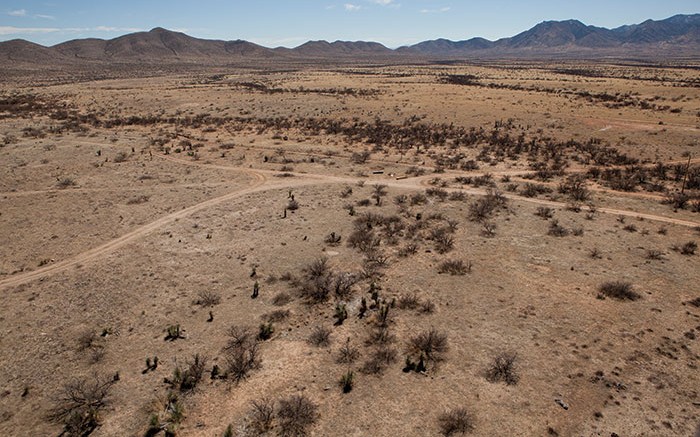A staged production approach at Excelsior Mining’s (TSXV: MIN; US-OTC: EXMGF) Gunnison copper project in southeastern Arizona would slash upfront capital costs and lower financing risk, while delivering a post-tax internal rate of return of more than 26%, even at today’s low copper prices of US$2 per lb.
Under the revised mine plan envisioned in a mid-February prefeasibility study, the facility would use in-situ recovery to initially produce 25 million lb. copper cathode a year, using a solvent-extraction-electrowinning (SX-EW) plant that Excelsior bought for US$8.4 million in December 2015.
Excelsior picked up the plant at a bargain from a previous company that had been in receivership since 2014, and now plans to pipe copper solution to the facility — 1.6 km north of Gunnison’s North Star deposit — for processing into copper cathode.
The new operating profile would speed the time to first production and better help the company fund future expansions out of cash flow. Excelsior would build a bigger plant later to expand the operation to 75 million lb. annually in year four, and to 125 million lb. per year in year seven.
Initial capital costs in the updated prefeasibility study have dropped to US$45.9 million from the US$285-million price tag envisioned in a 2014 study. “We wanted to get initial capital down low, because, frankly, it’s hard to raise capital right now,” Stephen Twyerould, Excelsior’s founder, president and CEO, says in a telephone interview.
In-situ mining methods also help Excelsior scale the project however it likes, he adds. If the company drills a lot of wells it will get more copper, but if it drills fewer wells, it will get less copper. “It’s different than open-pit mining, where there’s a fixed cost for the mining fleet, for stripping, for the leach pad — all those things are not scaleable,” he says. “For us, it’s just drilling. It’s the same cost for every drill hole, so we can scale the project easily.”
As for buying the SX-EW processing plant — it was pretty much a no-brainer. “We realized that if we purchased the SX-EW facility right next to us, that we could effectively pre-purchase our processing facility, and all we have to do is get permits, drill some wells and put solution through a pipe to the processing facility — and we’re in production.”
Under the new plan, Excelsior would produce an extra 400 million lb. copper than envisioned in the earlier prefeasibility, and extend the mine life by four years to 27 in total. While sustaining costs would rise from US$602.4 million in the 2014 estimate to US$735.2 million in the latest iteration, and all-in costs (capital and operating costs) would increase to US$2.7 billion from US$2.3 billion, unit costs would move lower.
Total sustaining capital costs would fall to US34¢ per lb. copper from US36¢ per lb. copper, and all-in costs would drop from US$1.34 per lb. copper to US$1.24 per lb. (Average life-of-mine operating costs are anticipated at US70¢ per lb.) “We’re a bigger operation. We’re producing an extra 400 million lb. copper … but unit costs, which are what people really focus on, are lower … and by lowering our unit costs, it’s a much better project.
“I’ve been working on this for 10 years — I formed the company and acquired the asset, so it’s not a surprise to me that it looks this good,” Twyerould continues. “One of the things we’ve been successful at is not over-promising and underachieving … it’s much better to be conservative in your estimations, and make sure you deliver.”
Key metrics of the latest study — based on a life-of-mine copper price of US$2.75 per lb. and a 7.5% discount rate — include a US$829-million post-tax net present value, 45.8% post-tax IRR and a post-tax payback of initial capital in slightly over two and a half years.
While posted recovery rates are 48%, this figure represents the percent of total copper recovered, he says, or 70% of the acid-soluble copper. “That’s a conservative number,” he says.
As far as permitting is concerned, Twyerould describes Cochise County as a “Republican-dominated” and “conservative” place where the economy is based around the military, agriculture, mining and some manufacturing, and that the company and its Gunnison project enjoy “good support.” (Excelsior also paid the county US$4 million in back taxes owed by the previous owners of its SX-EW facility.)
“Are people going to be concerned about putting a large amount of acid in the ground? The obvious answer is ‘yes’ … everybody would be concerned if there were no controls in place. We have to demonstrate to state and federal agencies that whatever we put in, we take out. That’s one of the rules of the permit.”
But Twyerould also points out the obvious: if Excelsior wasn’t removing all the acid it put underground, the operation would be uneconomic, on top of being “offside with permitting agencies.” Moreover, removing the acid from underground isn’t rocket science. The process involves creating a low-pressure zone using pumping wells that prevent solution from migrating from its site into the surrounding rock. “It’s like a hydrological barrier,” he explains, adding that the technique is the same as those used in barriers that keep seawater from entering freshwater areas in places like the state of California.
Finally, acid consumption is remarkably low for the type of host rocks, he says. The way it works, he explains, is that there are a lot of natural fractures underground. “They’re fractured and broken rocks, and the oxide copper is mostly on the surface of those structures and joints, and so the acid dissolves the copper along the fractures.
“We’ve done a lot of specific metallurgical and field tests that demonstrate that with in-situ recovery, our acid consumption is an order of magnitude lower than if this was an open-pit mining operation.”


Be the first to comment on "Excelsior updates Gunnison prefeasibility"